Fantasy Books
Goth Chick News: The Chicago Comic & Entertainment Expo Breaks Records for Nerdy Goodness
 C2E2 mailing insert with our Expo passes
C2E2 mailing insert with our Expo passes
Though Black Gate photog Chris Z and I have affectionately referred to ourselves as “horror nerds” almost from the beginning of working together, I was never quite sure if the term “nerd” was offensive to others. Therefore, in making a small nod to Big Cheese John O’s constant plea to not embarrass him, we only said “nerd” (and “geek” for that matter) in private or in hushed tones.
Then suddenly, either due to the term being liberally employed on the Netflix hit Stranger Things, or because compared to the rest of the world right now “nerds” are downright endearing, being one is akin to being a cool kid. So it’s no surprise that I absolutely loved the mailing insert that accompanied our Chicago Comic and Entertainment Expo passes this year.
 Chicago C2E2 Entrance Hall
Chicago C2E2 Entrance Hall
The Chicago Comic & Entertainment Expo, affectionately known as C2E2, is where the geeks and nerds collide with the fantastical and the macabre in a celebration of pop culture of epic proportions. Drawing fans, creators, and industry professionals from across the globe, this annual Chicago event is a haven for enthusiasts of comics, gaming, cosplay, television, movies, and more.
C2E2’s story begins in 2010, brought to life by ReedPOP, the masterminds behind globally recognized events like New York Comic Con and PAX. It was envisioned as a platform for fans to connect with their favorite creators and discover emerging talents across entertainment industries. Over the years, this vision has transformed into a pulsating, larger-than-life experience.
 The crowded halls of C2E2
The crowded halls of C2E2
We have been covering the show since its inception fifteen years ago, and it has gotten bigger each year, consuming more and more space in Chicago’s behemoth McCormick Convention Center. C2E2 2025 kept the trend going by achieving a record-breaking attendance of 100,000 fans over its three-day event, marking this year as the highest turnout in the convention’s history.
Of course, a couple of other “firsts” definitely contributed to the fandom crush. First up was a Lord of the Rings reunion that included Elijah Wood (Frodo Baggins), Sean Astin (Samwise Gamgee), Dominic Monaghan (Meriadoc ‘Merry’ Brandybuck), Billy Boyd (Peregrin ‘Pippin’ Took), John Rhys-Davies (Gimli), and Andy Serkis (Gollum).
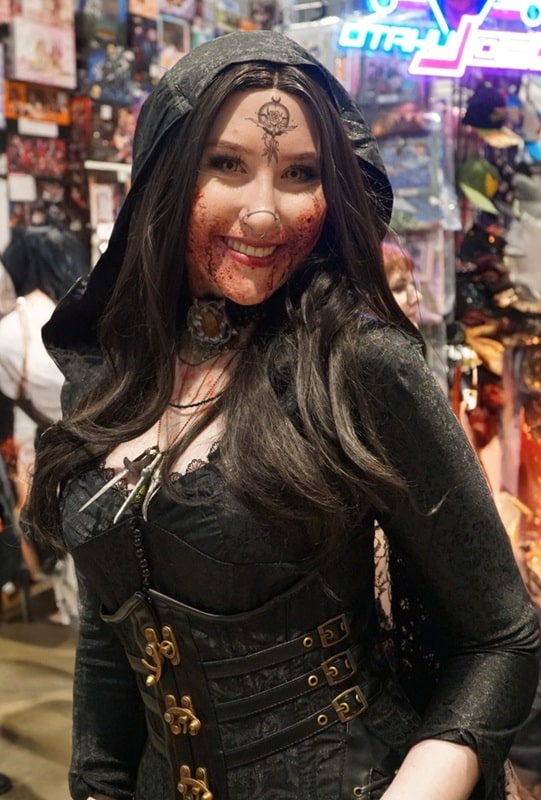 C2E2 cosplay
C2E2 cosplay
Though many of these actors have appeared together at other conventions such as the Fan Expo in New Orleans and Cleveland, C2E2 marked the first time they have all appeared at the same event. We walked by literally the longest line of people we have ever seen at a convention and learned it was for none other than Gollum (Andy Serkis) which is even more incredible when you think that his actual face never appeared in the film.
 The Breakfast Club reunion at C2E2
The Breakfast Club reunion at C2E2
Another first was a reunion of The Breakfast Club cast including Emilio Estevez (Andrew Clark), Molly Ringwald (Claire Standish), Judd Nelson (John Bender), Ally Sheedy (Allison Reynolds) and Anthony Michael Hall (Brian Johnson). This event was teased all over our local TV stations for the week leading up to C2E2 and generated a huge amount of buzz before, during and after the show. We had a great encounter with Anthony Michael Hall, but more on that in a few.
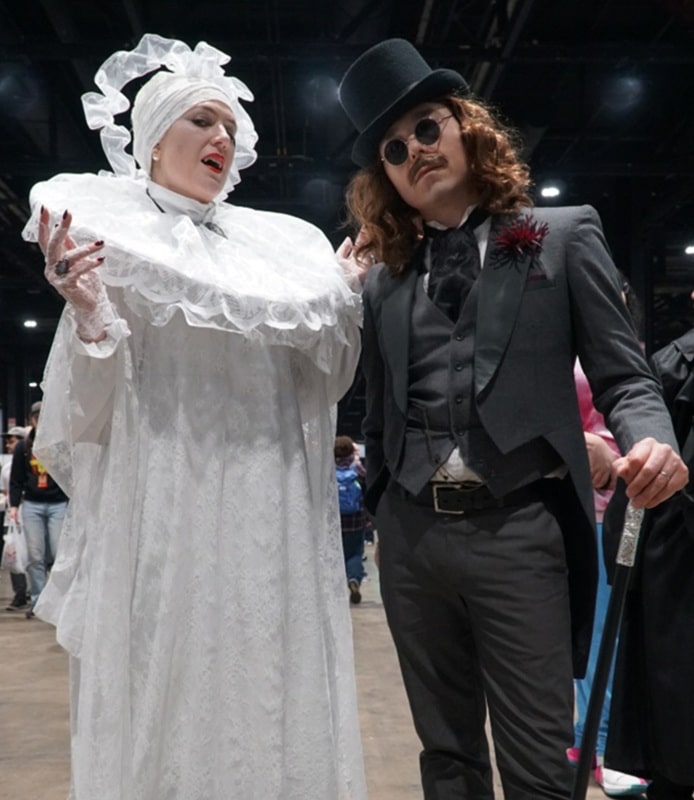 C2E2 cosplay
C2E2 cosplay
What makes C2E2 truly spellbinding is its seamless fusion of traditional comic convention staples with broader pop culture allure. While comic books and graphic novels form the heart of the expo, it’s also a playground for major studios, publishers, and independent creators unveiling their latest marvels. The event has become a must-visit destination for exclusive announcements, tantalizing sneak peeks, and insider insights.
C2E2 2025 played host to over 800 exhibitors and artists, so describing even a fraction of the cool stuff we saw would blow up Black Gate.com, but here are a few of our favorites.
 Geeky Girl Stitches
Geeky Girl Stitches
Geeky Girl Stitches: Creating handmade embroidered keychains paying homage to all manner of pop culture iconography, Tabitha Minnich wins for high-quality workmanship on these small bits of awesomeness that nearly everyone would want. We couldn’t believe the incredible range of interests represented by Tabitha’s merch; from Harry Potter to Disney, and Marvel to gaming there was something for everyone. Priced at $10 each Chris Z and I both walked away with some.
 I Contain Multitudes by Christopher Hawkins (April 30, 2025)
I Contain Multitudes by Christopher Hawkins (April 30, 2025)
Author Christopher Hawkins: There’s nothing like discovering a new horror author. His works of short fiction have been published in Sinister Tales, Murky Depths, and The Harrow, as well as in the anthologies Read By Dawn Vol 2, Shadow Regions, and The Big Book of New Short Horror. However, Hawkins was a C2E2 promoting his latest work I Contain Multitudes.
Unstuck from reality, Trina Bell never wakes up in the same world twice. Lost and alone, she crosses paths with an old librarian who is the only person who remembers her when everything else changes around them. When an encounter with a sadistic doctor makes Trina question whether she herself might be the cause of the shifting realities that are escalating out of control, she sets out to stop them.
As each successive world becomes more unstable and dangerous than the last-and with the librarian lost and descending into madness-Trina must confront the secrets rooted deep in her own past in order to find a way to repair her world before it collapses for good.
I Contain Multitudes will be available April 30th and is available for preorder on Amazon.
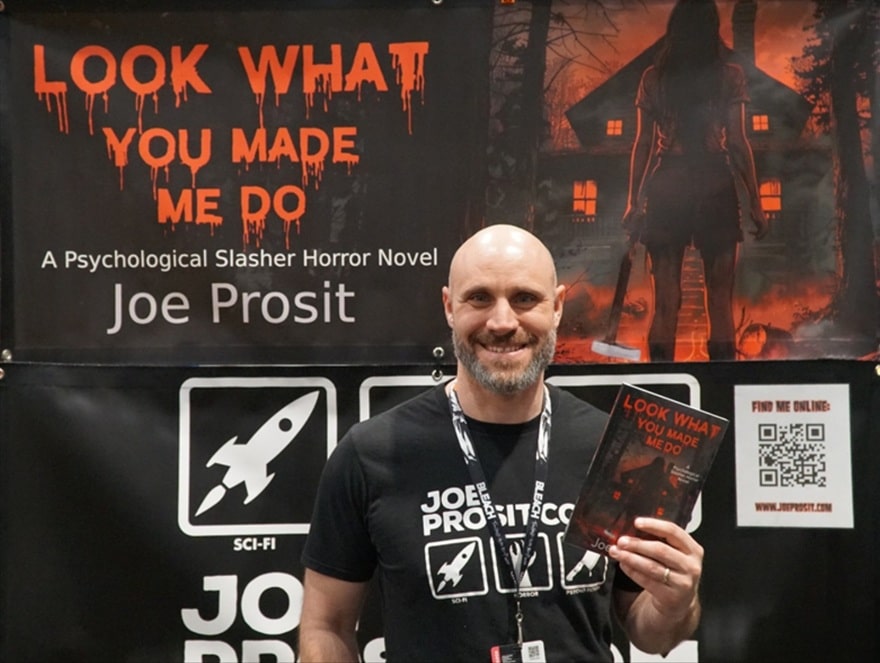 Look What you Made Me Do, by Joe Prosit (May 1, 2024)
Look What you Made Me Do, by Joe Prosit (May 1, 2024)
Author Joe Prosit: And while we’re gushing about new authors, we also were intrigued by Joe Prosit, an independent author living and writing in Brainerd, MN. His novels include Bad Brains, 99 Town, 7 Androids, Zero City, and most recently Look What You Made Me Do, a final-girl, psychological slasher horror which caught our attention.
At only seventeen, Taylor Mosley was the sole survivor of a brutal mass murder. She lived through “that night” and killed the madman who slaughtered her friends, but twenty years later, she still struggles to function in her modern corporate workplace.
Taylor is convinced the killer from her past is back and stalking her through her suburban neighborhood. Someone is sending her threatening texts, vandalizing her home, and following her on her daily runs. Is it her strange and aggressive therapist, her toxic ex-boyfriend, or the murderer from her youth? She manages to get free of her ex, only for the police to become more interested in what she’s done than who is still after her. As the threats of her present day collude with the nightmare of her past, she struggles to understand what is real, what is memory, and what is hallucination.
Maybe someday she can enjoy her idea life, but for now, Taylor must evade the police, unmask her tormentor, juggle her romantic relationships, find a healthy work-life balance, quench her thirst for revenge, and make a stand for women everywhere while still finding time to relax and enjoy a nice merlot.
Prosit has published many short stories in various magazines and podcasts and compiled them in his short story collection title, Machines Monsters and Maniacs Volume I. The second volume is coming this October. Look What You Made Me Do is available now on Amazon.
 Fandom Alley
Fandom Alley
Fandom Alley: Producing what they explain are “Film Cell” presentations, Fandom Alley has framed art that contains one or more clips of real 35mm film from the movies. We pressed the representative we spoke to regarding the classic horror movies they had on display, specifically as I was drooling over Bela Lugosi’s Dracula.
Clearly these aren’t cells from original films as cutting those would not only be blasphemous but downright impossible. The rep told us that each cell was real film from the movie and each art piece came with a certificate of authenticity. Beyond that, he could not say more has he was “bound by a non-disclosure agreement.”
So, the bottom line is these are real cells of real movie reprints, but still, one of the coolest things we saw – especially as they had small light boxes that fit behind the framed pieces making them true bits of art. Prices start at $35 and go up from there, and are available online.
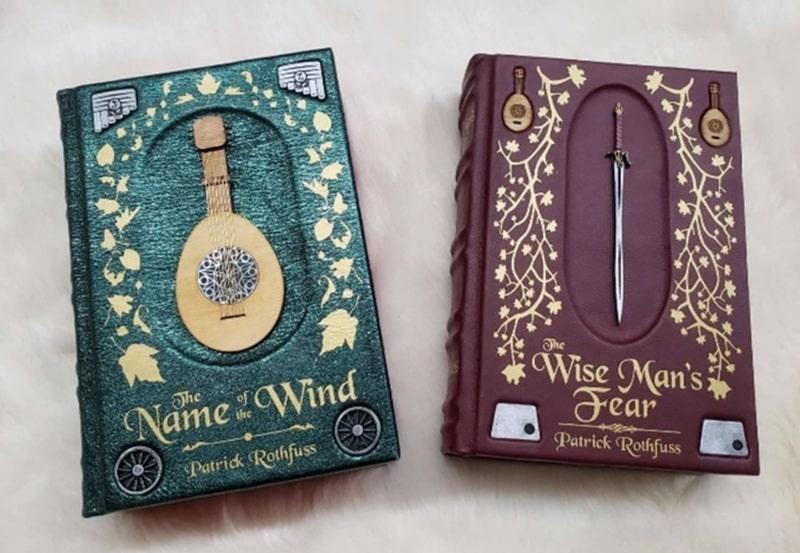 Geekify does Patrick Rothfuss
Geekify does Patrick Rothfuss
Geekify: We first met the crew from Geekify at C2E2 2015 where I purchased a leather cover for my tablet that looked the “Handbook for the Recently Deceased” from Beetlejuice. A Colorado-based creative studio that masterfully blends the realms of geek culture with artisanal craftsmanship, Geekify Inc operates as a fusion of a mad scientist’s lab and a full production workshop.
They officially license pop culture merchandise from beloved franchises such as The Princess Bride, Labyrinth, and The Hobbit, and their booth featured an array of handcrafted items, including leatherbound books, cloth maps, enamel pins, and cosplay accessories, all reflecting their commitment to quality and detail. They also make custom items such as maps, and I’ve already hit them up for a “life size” version of the map of the ” time holes” of the universe, from the 1981 film Time Bandits.
 Chicago C2E2
Chicago C2E2
Chicago Horror Writers: The HWA Chicagoland Chapter is the regional chapter of the Horror Writers Association. The Chapter consists of local writers, editors, artists, publishers in and around the Chicagoland area to help support, promote and network with others in the genre. The Chapter hosts monthly meetings at local libraries and/or bookstores in the Chicagoland area for anyone who is interested in horror or dark literature.
The Horror Writers Association (HWA) is a nonprofit organization of writers and publishing professionals around the world, dedicated to promoting dark literature and the interests of those who write it. HWA was formed in 1985 with the help of many of the field’s greats, including Dean Koontz, Robert McCammon, and Joe Lansdale. Today, with over 1250 members in countries around the world, it is the oldest and most respected professional organization for the much-loved writers who have brought you the most enjoyable sleepless nights of your life.
I am super excited about meeting members of the Chicago chapter and am in the process of establishing membership after all these years of covering HWA’s Stoker awards.
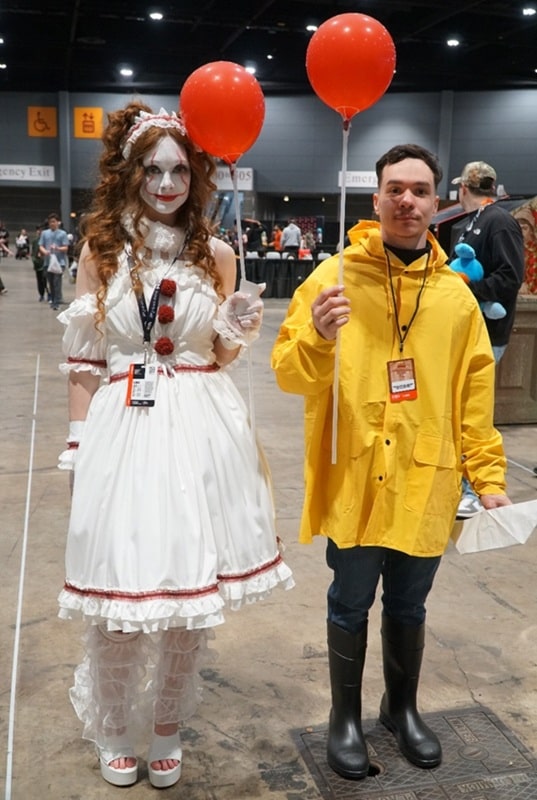 It cosplay at C2E2
It cosplay at C2E2
And finally, a short story of our meeting with Anthony Michael Hall. Chris Z and I were walking past the many celebrity tables trying to get a peep at some. The configuration has the celebrities at quite a distance, behind long, roped off aisles where the hoards of fans line up. As it was late in the afternoon on a Friday, some celebrities were gone while others weren’t making an appearance until Saturday.
We walked by the area where the stars of The Breakfast Club were seated, though only the boys were in attendance on Friday. The only person at his table was Anthony Michael Hall and I paused at the end of his aisle squinting to get a look at him. It looked like he might be packing up for the day as there was no line of fans. Hall was chatting with his C2E2 “handler.”
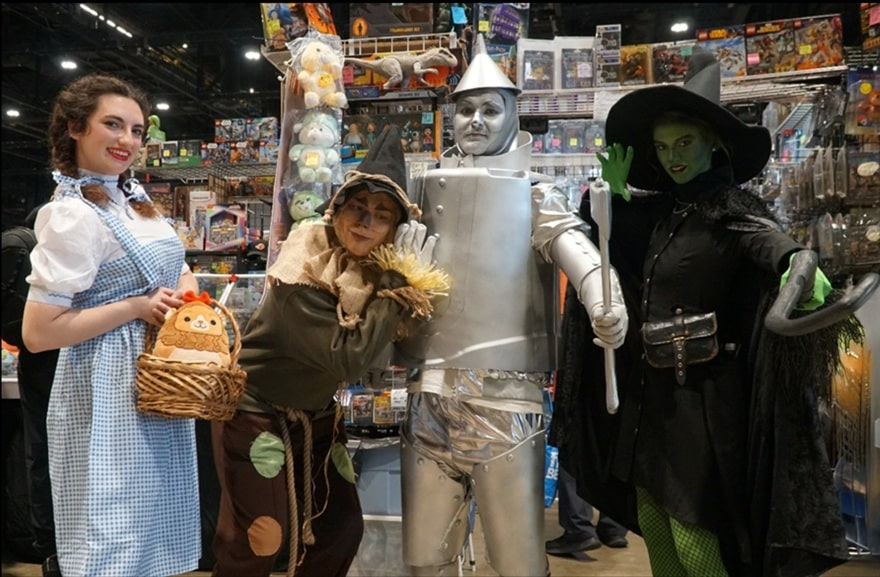 Gone With the Wind cosplay at C2E2
Gone With the Wind cosplay at C2E2
Suddenly, Hall looked up and raised his arm, waving enthusiastically in my direction. Instinctively I raised my hand and waved back with equal enthusiasm and started making my way down the aisle toward him. Chris Z recovered from his temporary shock and said, “Wait! You know Anthony Michael Hall???” I said, “Sort of, we have some mutual friends.” Chris just kept saying, “Wait! What?”
When I reached Hall’s table a little ahead of Chris, I whispered to Hall to play along. I then proceeded to say how great it was to see him again, and he did the same. We acted like old friends while Chris was speechless. I finally owned up, and the three of us had a wonderful chat. Hall told us stories about filming in Chicago and his great memories of our city. And who had Hall really been waving to? None other than Judd Nelson who stuck his head around a curtain to also say hello.
Looking ahead, C2E2 2026 is scheduled for March 27–29 at McCormick Place. For more information and updates, visit the official C2E2 website. Embrace the dark, the delightful, and everything in between — it’s what C2E2 does best.
Women in SF&F Month: Lindsey Byrd
Today’s Women in SF&F Month guest is Lindsey Byrd! She is the author of On the Subject of Griffons, a fantasy novel about a woman who ends up working with her deceased husband’s former mistress to seek a magical cure for one of her children. The Sun Blessed Prince, her next novel, is the first book in an epic fantasy duology with romantic elements that features a prince and an assassin with opposing gifts who might be able to put […]
The post Women in SF&F Month: Lindsey Byrd first appeared on Fantasy Cafe.Spotlight on “Harriet Tubman Live in Concert” by Bob the Drag Queen
Harriet Tubman Live in Concert is an inventive, wondrous novel about American hero Harriet Tubman…
The post Spotlight on “Harriet Tubman Live in Concert” by Bob the Drag Queen appeared first on LitStack.
On McPig's Wishlist - Her Soul for a Crown
 Her Soul for a Crownby Alysha Rameera
Her Soul for a Crownby Alysha RameeraFor readers of Sarah J Maas, Scarlett St. Clair, and Tasha Suri's The Jasmine Throne, this epic, slow-burn romantasy inspired by Sri Lankan mythology follows a fierce orphaned young woman with an affinity for poisons and revenge who would do anything to end the reign of heartless rajas—even sell her soul to the most dangerous cursed god of all—the Blood Yakka, Reeri.
Anula Ramanayake of Anuradhapura calculated her ascent the moment she was orphaned—when her village burned in an endless war and the gods forsook her prayers. First, she would marry the raja. Then, she would poison him and take the throne for herself and her people. But when an unexpected coup thwarts her careful plans, Anula is left with one desperate option. She offers her soul to the cursed gods she renounced in exchange for the crown.
In the Second Heavens, Reeri the Blood Yakka, the most dangerous and powerful of his clan, hears her prayer. For eons, he's waited for such a valuable offering—one that could finally give him the chance to kill his divine tormentor and return his fellow Yakkas to their former glory on earth. Reeri accepts Anula's bargain, tethering them until their goals are achieved, or until they die.
As the war presses on, Anula must move quickly or lose her chance to become the first raejina. But while she is skilled at many things, especially in stopping hearts, the closer she grows to Reeri, the more she finds her own heart at risk. And when the time comes to fight enemies both human and divine, Anuradhapura and the Heavens will never be the same.
Expected publication August 12, 2025
Book review: The Glorious and Epic Tale of Lady Isovar by Dave Dobson

ABOUT THE AUTHOR: A native of Ames, Iowa, Dave loves writing, reading, boardgames, computer games, improv comedy, pizza, barbarian movies, and the cheaper end of the Taco Bell menu. Also, his wife and kids.
Dave is the author of Snood, Snoodoku, Snood Towers, and other computer games. Dave first published Snood in 1996, and it became one of the most popular shareware games of the early Internet. His most recent game is Scryptix, a word game for cell phones.
Dave taught geology, environmental studies, and computer programming at Guilford College for 24 years before stepping away to write full time. He does improv comedy every week at the Idiot Box in Greensboro, North Carolina. He’s also played the world’s largest tuba in concert. Not that that is relevant, but it’s still kinda cool.
Publisher: Dave Dobson (May 21, 2024) Length: 395 pages Formats: ebook, paperback
I did not expect to enjoy this one as much as I did. I picked it up thinking I was in for a goofy sword & sorcery romp and I was right. What I didn't expect was how much personality it packed between the quips, one-liners, and brawls.The Glorious and Epic Tale of Lady Isovar is a fun mix of sword & sorcery, heroic epic, Monty Pythonesque humor and a buddy-cop tropes. Lady Isovar is a knight in shining armor. She’s brave, bold, big on honor, and low on planning. She's also unstoppable.
Chevson, her squire and damage control specialist, trails behind with a notebook and a growing sense of dread. He's doing his best to rescue bystanders and stop Izzy from offending people or starting conflicts. The lad deserves a raise.
The plot is quite simple - there’s a wrong that needs righting, and by the gods, Izzy will right it! Possibly twice, just to be safe. The duo faces lots of classic fantasy villains - necromancers, dragons, tyrants, an oversized snake, and more. Lady Isovar dispatches them with a flair, usually in fun and chaotic ways. The plot consists of multiple interconnected (mostly) mini-quests.
Tonally, it’s a joyful romp with likable characters, laugh out loud moments, and no brooding. The humor worked for me - it's clever, a little absurd, and occasionally so ridiculous I couldn't help but laugh. The sacred vows alone are worth attention. The friendship between Izzy and Chevson glues everything together. The knight has ADHD and the squire is just trying to get through the day without concussion, but despite being so different, they make a wonderful team.
Dobson pokes fun at genre tropes but in a good-natured way and with respect. Brave deeds and heroic speeches do happen, but they never feel forced or out of place. Instead, they add some nuance, especially that Izzy's past isn't explained for a while.
Now, the humor is very subjective. so it may not work for everyone. And yet I believe the humor here is good-natured, not very cynical and balanced so cjhances are most readers will find it amusing. Especially that beneath all the hijingks and jokes, there’s a surprising bit of heart. And the leading duo has an excellent chemistry and dynaimicvs.
It’s silly. It’s heartfelt. It’s occasionally bloody. And I very much enjoyed the ride. I’d follow these two into battle.
THE STAIRCASE in the WOODS by Chuck Wendig
Book Review: The Butcher’s Masquerade by Matt Dinniman
I received a review copy from the publisher. This does not affect the contents of my review and all opinions are my own.
 The Butcher’s Masquerade by Matt Dinniman
The Butcher’s Masquerade by Matt Dinniman
Mogsy’s Rating: 5 of 5 stars
Genre: Fantasy, Science Fiction
Series: Book 5 of Dungeon Crawler Carl
Publisher: Ace (April 8, 2025)
Length: 720 pages
Author Information: Website
Five books in, and Matt Dinniman shows no signs of slowing down! The Butcher’s Masquerade is arguably the darkest and most unhinged book in the Dungeon Crawler Carl series—so far, at least—and I say that with the utmost glee. Observant readers will also notice that each subsequent volume has grown longer in page length, and that truly is a direct consequence of the story becoming bigger in every way.
A new sequel means a new level, as Carl and his cat Donut continue their deadly descent into the dungeon which formed after the hostile takeover of Earth by a massive, alien-run game show. The duo finds themselves on the sixth floor, also known as The Hunting Grounds. As with every third floor, the dungeon introduces a major mechanic, and the rules are turned upside down once again as outsiders registering as hunters are allowed to enter the dungeon for the first time. Most of these will be tourists, paying for the once-in-a-lifetime opportunity to bag a few crawlers, but a good number of the participants will also be seasoned professionals. Among them are the famed veterans who live for the glory of the hunt, and they will be brutal and merciless, playing to collect as many trophies as they can.
The remaining crawlers, whose numbers have dwindled to a fraction of what they once were, now must contend with these aliens hunting them on top of trying to survive everything else the dungeon will be throwing at them. For Carl and Donut, who have consistently stayed in the top ten crawlers list, this also means their bounty will be especially attractive to hunters. Of course, it hasn’t helped that Carl has been putting up a resistance against the showrunners and their supporters, poking a finger in their eye every chance he gets. But all this is done with a purpose. Unlike previous iterations of the dungeon crawl, this season Carl and his fellow crawlers will not be helpless, because he’s made damn sure the Earth survivors won’t go down without a fight.
Every book in this series raises the stakes, but in this one, they escalate dramatically. Dinniman has turned up the tensions and delivers some of the most satisfying moments yet, especially the ending when the hunt culminates in the titular Butcher’s Masquerade, a pivotal plot point but also a grand party that celebrates the coming together of the various and often antagonistic groups of guests who are all expected to play nice for just that one night. That’s because everyone in attendance is promised a gift in the form of a boon from an in-game deity, but there’s a catch—the gathering must conclude without any violence. In the long history of the crawl though, that has never happened. And with Carl and his friends in the mix, you can bet that’s not about to change now.
World-building also steps up a notch in this installment. Even as crawlers and hunters duke it out on the sixth floor, a greater struggle is unfolding in the greater galaxy as the structure of the game, those investing in it, and the political maneuvering of the alien factions all get more attention. These glimpses behind the scenes make Carl’s quest even more critical while still maintaining the personal nature of his revenge. At this point, series fans who have long learned to embrace the chaos will be rewarded with meaningful action and payoffs, with our protagonist unleashing retribution in a way only he can—in a torrent of ruthless mayhem.
And yet, while the tone remains humorously irreverent and action-packed, there’s also a deeper, emotional thread running beneath the surface that changes the game entirely for the characters and readers alike. Carl might be growing more powerful with each level and loot box, but the horrible things he’s seen and experienced have left their mark. The story balances his rage and thirst for vengeance with heartfelt moments of humanity, where grief and despair will come to the surface, but so too do hopeful feelings like love and camaraderie. The relationship between Carl and Donut continues to develop in wonderful, surprising ways, with both their arcs taking darker and more complex turns, but it’s their undying support for each other that keeps their friendship strong and the banter light.
Finally, if I had any reservations about Dinniman losing control of the snowballing narrative, he’s proven that he can keep multiple plotlines in the air and juggle them without neglecting any of them. But how long will that last? Admittedly, I’ve started noticing a bit of wobbling in this book’s pacing—some slowing down in the middle as the story branches off into side quests and supporting character arcs, which is the natural result of an expanding series and its growing universe. Sometimes the narrative will linger a little too long on something that doesn’t always feel essential, even if it is entertaining. It’ll be interesting to see if future installments can maintain the same tight balance of content and clarity as more books are added and the plot keeps getting more complicated.
Bottom line, the Dungeon Crawler Carl series is unlike anything else out there, as Matt Dinniman continues to single-handedly redefine the LitRPG genre. Onward to the next level!
![]()
![]()
More on The BiblioSanctum:
Review of Dungeon Crawler Carl (Book 1)
Review of Carl’s Doomsday Scenario (Book 2)
Review of The Dungeon Anarchist’s Cookbook (Book 3)
Review of The Gate of the Feral Gods (Book 4)
Women in SF&F Month: Mia Tsai
Today’s Women in SF&F Month guest is Mia Tsai! Her debut novel, Bitter Medicine, is a xianxia-inspired contemporary fantasy book featuring a magical calligrapher descended from the Chinese god of medicine and a half-elf security expert working at the same agency. The Memory Hunters, her second novel coming out on July 29, is the first book in a science fantasy duology featuring an archaeologist and her protector that is described as a “mind-bending queer adventure for fans of Inception, Arkady […]
The post Women in SF&F Month: Mia Tsai first appeared on Fantasy Cafe.The Eccentric’s Bookshelf: Michael Weldon’s Psychotronic Encyclopedia of Film
1983? Let me tell you how it was.
In a World Without the Internet, before Youtube, before Netflix, before Prime, before 4K UHD smart TVs, before social media or Substack or niche newsletters, before IMDb and Rotten Tomatoes, before DVDs and Blu-rays, even before blogs (gasp!), you would find yourself sitting around late at night, channel surfing, listlessly flipping through TV Guide, restlessly looking for something to watch, and you would come across a movie like The Horror of Party Beach and you would think, “What the hell? Is this worth ninety minutes of my life?” And since you would likely have only once chance to see the thing, it was a decision fraught with import. (I’ve always wanted to use that phrase.)
In the absence of all of the resources and options we now take for granted, how did you decide what to do? I’ll tell you what I did — I reached for The Psychotronic Encyclopedia of Film.
The brainchild of Uber-Geek Michael Weldon and an offshoot of his Psychotronic Video magazine, the book is, according to the back cover, “The complete viewer’s guide to the weirdest movies of all time!” It’s a boast that the volume makes good on with one pseudopod tied behind its back.
The back cover also sports an important disclaimer:
WARNING! The author of this book has been watching these movies obsessively since the age of 6. He is now unfit for conventional employment. Because of the addictive nature of these films, we the publishers cannot guarantee that your sanity won’t be endangered by reading this book.
Just what is a “psychotronic” movie? Well, it’s a broad category covering all manner of films, from horror and science fiction to juvenile delinquent dramas to women behind bars sleaze to sword-and-sandal epics; in other words, low-budget exploitation movies generally, with some exceptions for big-budget productions with low-budget souls. To again quote the back cover (and let me tell you, it’s one of the greatest back covers of all time — and the front cover is no slouch, either),
From the slightly offbeat to the outlandishly bizarre… from the no-budget quickie to the multimillion-dollar box-office smash… PSYCHOTRONIC films range from Attack of the Killer Tomatoes to E.T…. from Angel’s Wild Women and Hellcats of the Navy to I Dismember Mama and Let Me Die a Woman… from sincere social commentary to utter trash. PSYCHOTRONIC stars are ex-models, ex-sports heroes, dead rock idols, future presidents, would-be Marilyns, and has-beens of all types.
Once you manage to get past the cover — no easy task — the book consists of over 3,000 punchy reviews of psychotronic movies (most written by Weldon himself), seasoned with tons of great photographs: movie posters, lobby cards, publicity stills, and images from the actual films adorn almost every page.
It was a great day when I bought my first copy of The Psychotronic Encyclopedia. (I’ve gone through several over the years, and when I wear one out, I give it to a prospective acolyte; I aim to earn my way into psychotronic heaven by actively proselytizing. These days if you want a copy your best bet is eBay, where you can also find copies of Psychotronic Magazine.)
In the bad old days, it was extremely hard to find out about these films, and a surprising number of people — some of them capable of speaking in complete sentences and holding down real jobs, believe it or not — wanted precisely the kind of information that only The Psychotronic Encyclopedia could provide.
But don’t take my word for it. Let card-carrying Respectable Citizen and certified Hero of the Mainstream Literary Establishment Colson Whitehead, who won the National Book Award and the Pulitzer Prize for his novel The Underground Railroad and who also penned the zombie apocalypse saga Zone One, vouch for the value of the psychotronic worldview. Whitehead declared that
Weldon’s book was proof that even the most unlikely idea had a chance. If these movies existed, then surely whatever measly story was bubbling in my brain was not so preposterous. The psychotronic movie’s disregard for mimesis, its sociopathic understanding of human interaction, its indifferent acting, and its laughable sets were a kind of ritualized mediocrity. The filmmakers were so inept in their portrayal of any kind of recognizable reality that their creations became a form of grubby science fiction, documentaries about an alternative planet.
Bull’s-eye. Disreputable, shocking, embarrassing, tasteless, tacky, trashy, revolting, hilarious (intentionally or, more commonly, unintentionally), utterly free from the constraints of competence and good manners imposed on “serious” filmmakers, offhandedly subverting every decent value (often including that of minimal coherence), psychotronic films are rebellion made flesh — or celluloid. Just watching one feels like striking a blow for liberty, and Michael Weldon’s book is a revolutionary manifesto more radical than anything ever tossed off by Marx and Engels. (Just imagine what that pair of stuffy Germans would have made of Hot Rods to Hell or Robot Monster!)
Of course, because the book was published in 1983, it also an artifact from A World Without any Movie Made over the Last Forty Years — no Repo Man, no Silence of the Lambs, no Dark City, no Revenge of the Sith (ok, not having that movie might be a feature rather than a bug), no Shaun of the Dead, no Independence Day.
This admittedly limits the Psychotronic’s utility somewhat, but I still find myself thumbing through its well-worn pages with embarrassing frequency. Sometimes you just have to know who starred with Bela Lugosi in The Devil Bat or what year Roger Corman made Ski Troop Attack, and it’s one of those books that’s truly like a bag of potato chips — you can’t read just one entry. Before you know it, you’ve blown an hour seeing if Weldon did justice to Count Yorga, Vampire or The Mole People, gaining new insight into Werewolf in a Girl’s Dormitory or Whatever Happened to Baby Jane, and admiring photographs of Chubby Checker, Jayne Mansfield, and Vincent Price (not from the same movie, unfortunately — some things will never happen this side of paradise).
Anyway, if the years 1984 to 1995 are all that important to you (I can barely remember them, myself) Weldon produced a second volume called The Psychotronic Video Guide in 1996. But while the original Psychotronic Encyclopedia still lives right under my wide-screen TV where I can lay hands on it at a moment’s notice, I found that I never used the Psychotronic Video Guide that much.
Maybe that’s because by 1996 we were on the cusp of a change the magnitude of which we couldn’t even begin to imagine, and the old world of B-movie, cult movie, low-budget, late-night old movie TV was about to vanish forever, or at least be transformed almost beyond recognition. Today if you want to investigate The Horror of Party Beach, you can watch it any hour of the day or night on Youtube (at least as of last weekend — as you know, the streaming world is as inconstant as our nation’s trade policy) and there are countless people on that same platform who do nothing but yammer endlessly about these kinds of movies.
It’s great, in its way, but sometimes I miss the old days when opportunities were fleeting and consequently the choices seemed more important; hell, I even miss the used car commercials.
So, what did I do about that non-hit of 1964, The Horror of Party Beach, when I came across it all those years ago? Did I sacrifice an hour and a half of the only life I’ll ever have to watch such a manifest piece of junk? Such a momentous decision would paralyze most people, but I consulted the Psychotronic Encyclopedia, and on page 331 I was told,
Forget anemic teen horror movies like Ghost in the Invisible Bikini. This low-budget gem from Stamford, Connecticut, features kids on the beach dancing to “The Zombie Stomp” and a girl who drinks hard liquor and strips for bikers. Meanwhile radioactive waste turns human skulls on the bottom of the ocean into horrible monsters! They kill the wayward girl on the beach, then all the girls at a slumber party. If you don’t understand what’s happening, newspaper headlines (MONSTERS STRIKE!, MONSTERS STRIKE AGAIN!, and MASS MURDER AT SLUMBER PARTY!) are shown to keep you informed. With great music by the Del-Aires, lame jokes, phony blood, a sportscar driven through New York City, and a maid named Eulabelle who saves the day by knocking a beaker of sodium on a living monster hand, which promptly disintegrates. Billed as “the first horror monster musical!” it’s a cool classic that was also turned into a photo comic book. EXTRA! EXTRA! FIVE MORE KILLED BY MONSTERS!
Did I watch The Horror of Party Beach?
Don’t ask stupid questions.
Thomas Parker is a native Southern Californian and a lifelong science fiction, fantasy, and mystery fan. When not corrupting the next generation as a fourth grade teacher, he collects Roger Corman movies, Silver Age comic books, Ace doubles, and despairing looks from his wife. His last article for us was Movie of the Week Madness: Duel
7 Author Shoutouts | Authors We Love To Recommend
Here are 7 Author Shoutouts for this week. Find your favorite author or discover an…
The post 7 Author Shoutouts | Authors We Love To Recommend appeared first on LitStack.
Phantasma - Book Review
 Phantasma (Wicked Games #1)by Kaylie Smith
Phantasma (Wicked Games #1)by Kaylie SmithWhat is it about:When Ophelia and her sister discovers their mother brutally murdered, there is no time to grieve: Ophelia has inherited both her powerful death-driven magic and enormous debt on their home. Circumstances go from dire to deadly, however, when Ophelia’s sister decides to pay off the loan by entering Phantasma—a competition where most contestants don’t make it out alive and the winner is granted a single wish.
The only way to save her sister is to compete. But Phantasma is a cursed manor, with twisting corridors and lavish ballrooms, and filled with enticing demons and fatal temptations. Ophelia will need to face nine floors of challenges to win... if her fears don’t overtake her first.
When a charming, arrogant stranger claims he can protect and guide Ophelia, she knows she shouldn’t trust him. While Blackwell may not seem dangerous, appearances can be deceptive. But with her sister’s life on the line, Ophelia can’t afford to turn him away. She just needs to ignore the overwhelming, dark attraction drawing them closer and closer together.
Because in Phantasma, the only thing deadlier than losing the game is losing your heart.
What did I think of it:Ever since Battle Royale (Yes, long before The Hunger Games) I've had a soft spot for stories where people have to take part in dangerous/deadly games. It's almost as good as some decent zombie mayhem. So even though I suspected it might be more romance than action I got my trotters on this book. When I finally picked it up to read for an online book club, Voodoo Bride decided to read along.
And we both had a great time with this book!
I will say I really liked Ophelia, which surprised me as she's (once again) an older sister thinking she needs to save her younger sister. But where I usually dislike those meddling older siblings who think they know better Ophelia surprised me. She doesn't think she's better. Far from it in fact, she feels like a failure, has her inner demons, and feels like she is at fault for her younger sister disappearing, hence why she enters Phantasma to find her sister.
Then there's the whole game element which was really cool and exciting. There are scheming contestants, thrilling tests, death, creepy and icky stuff, hauntings, you name it. The whole of Phantasma was really well thought out, and had me engrossed, eager to find out what would be thrown at Ophelia next.
The romance was also excellent (and super delicious according to Voodoo Bride) and we rooted for Ophelia to win both Phantasma and at love. Blackwell was a very cool character (and dreamy and yummy) who clearly has his own agenda, still we rooted for him as well.(We could easily guess what his deal was, but if a story is as well written as this was, that doesn't really matter.)
Overall a really awesome read. We will most definitely get book two as well.
Why should you read it:It has it all: action, romance, thrills, & mayhem.
A Boy and His Dog: How Archaeology is My Biggest Inspiration
 Image by Siggy Nowak from Pixabay. This looks like a Stargate. Where’s the dial?
Image by Siggy Nowak from Pixabay. This looks like a Stargate. Where’s the dial?
Good afterevenmorn, Readers!
Once upon a time, a much younger me fell into an obsession… Well, several related obsessions, if I’m being honest. Prehistoric Anthropology and Archaeology dug its claws into my brain and would not let go. In what might have been a profound waste of money, I followed that obsession into university, acquiring a Bachelor’s Honours Degree in the subject, with a focus on Celtic Studies. I wrote a thesis that was four times as long as it needed to be (with permission). I wrote on the Continuity of Religious Iconography From the Upper Palaeolithic to the Pre-Roman Iron Age of the Atlantic Façade. Which is to say, basically, some religious beliefs and practices of the Iron Age Celts might just have had their origin in the pre-Celtic peoples of the Stone Age. That’s a lot to cover in just twenty pages, so I handed in eighty-three.
When I say I was/am obsessed, I absolutely meant it.
 Image by WikiImages from Pixabay
Image by WikiImages from Pixabay
I had wanted to follow that obsession even further in a Master’s Degree and then onto a Doctorate, but I had no money, and was far too scared of my already accrued debt to willingly go further. As such, I’m not really working in my field of study. In fact, I’m nowhere near it. My day job is working as an accounting clerk. But that doesn’t mean I haven’t used my degree. I have. Sort of.
You can find me still pouring over news from the prehistoric anthropology and archaeology world. The information sits in my head and ferments, becoming part of the fabric of my imagination. Every so often, that information pops out in the form of a fictional story. Sometimes, there are things that are discovered after a story is written and out in the world that reflect the stories so very well. Let’s explore!
 Image by Joshua Choate from Pixabay
A Child and Their Dog
Image by Joshua Choate from Pixabay
A Child and Their Dog
In 1994, Jean-Marie Chauvet discovered a cave in southern France later named for them (Chauvet-Pont-d’Arc). Inside, undisturbed, thanks in large part of a landslide that sealed off the cave, were tracks, cave art and animal figurines dating back to the palaeolithic. Of particular note were the fossilised footprints of an eight-year-old child dating back some 26,000 years. The child was barefoot and walking, making the tracks beside his remarkable. These were the tracks of a very large canine. Possibly a wolf. The child was not running, so there wasn’t any kind of pursuit. This discovery has led to some interpretations that this child and the large canine were quite possibly travel companions.
In 2010, I published a collection of short-stories all designed to be quite like fairytales or origin myths. Included in this anthology – The Dying God & Other Stories – was the story The Taming of Man I. In this tale, a young orphan boy is adopted by the ancestor of the Black Hounds; a giant, wolf-like dog named Cysgod Mawr (literally: The Great Hound). They travel together, away from the volcano responsible for the death of the boy’s parents and Cysgod Mawr’s pups both. It is the mythological telling of how wolves came to be domesticated.

This is an example of something that was discovered long after a story was written that just fits with the story so very well. In 2017, I was lucky enough to have a historical fiction published by Renaissance Press. Set in Roman occupied Britain and Gaul, Daughters of Britain follows the eldest of Boudicca’s daughters. Boudicca, incidentally, in one of my favourite historical figures. If you want to hear me rant at length, just mention her. I will not shut up. I know that not everyone has heard of her, but in short, Boudicca was the queen of a powerful Celtic tribe in the south east of Britain called the Iceni or Magni Ceni. The long and short of it is that Rome treated her and her people horribly; claiming them annexed following the king’s death when they were, in fact, a client kingdom. That distinction matters. Anyway, Boudicca and her two daughters were not treated well. That is an understatement. Boudicca was stripped naked and publicly flogged. Her two daughters both very young were raped. In retribution, Boudicca gathered warriors from three separate tribes of the south east and went on a rampage around the region. So much so that there is a layer of blood, ash and broken pottery in the archaeological strata dubbed the Boudiccan Destruction Horizon.
She is goals.
Anyway, she was eventually defeated, and died either from her wounds of taking poison to avoid capture. We don’t know what happened to her daughters. So I kind of… made it up. I sent them north to the Caledonian Federation, where the eldest, Mederei, joined the resistance and continued her mother’s fight for British freedom. In my imagination, she remained in the north, fighting for the remainder of her life.
This year, a month ago in fact, there was a discovery near Melsonby, North Yorkshire, of an incredible Iron Age hoard, dating to roughly the time when Boudicca was about. Folks have immediately jumped to naming it the burial of Cartimandua (Cartimandua was queen of the Brigantes, a powerful northern British Celtic tribe in the region and a contemporary of Boudicca. She was also a pro-Roman ruler and thus deeply unpopular). Near as I’ve read, human remains have yet to be found, so a burial is not yet the verdict. This could be an impressive collection of grave goods. Or it could be something else. Either way, given the deep unpopularity of the queen, and the rescue of her by Roman auxiliaries when her ex-husband and his forces attacked the capital in order to take it from her (successfully, I might add), makes it unlikely that Cartimandua would be buried there. Certainly not with honours.
But an another woman could be. One who fought with her fellows for freedom against Roman imperialism… Boudicca’s eldest daughter. At least, that’s where my mind went the moment the news of “Cartimandua’s Burial Discovered” headlines hit my feed (no one’s even sure if it’s a burial yet, so that’s quite the claim to make).
A double aside about this story — I got the name Mederei from Trioedd Ynys Prydein (The Welsh Triads), which lists three female champions of the island of Britain: Llewei daughter of Seitwed, Rorei daughter of Usber, and Mederei Badellfawr (Mederei “Big Knee,” lol). The Trioedd Ynys Prydein are collections of things in triplicate, possibly the written down version of what was a mnemonic device designed to help remember the names of important people, and thus their important deeds and therefore the history of the island of Britain. Alas, for the most part, only the names survived. The deeds of most are lost (and I weep). But it’s an excellent place to go hunting for names, in case anyone gets stuck. Also, a fantastic source for early Arthurian myth.
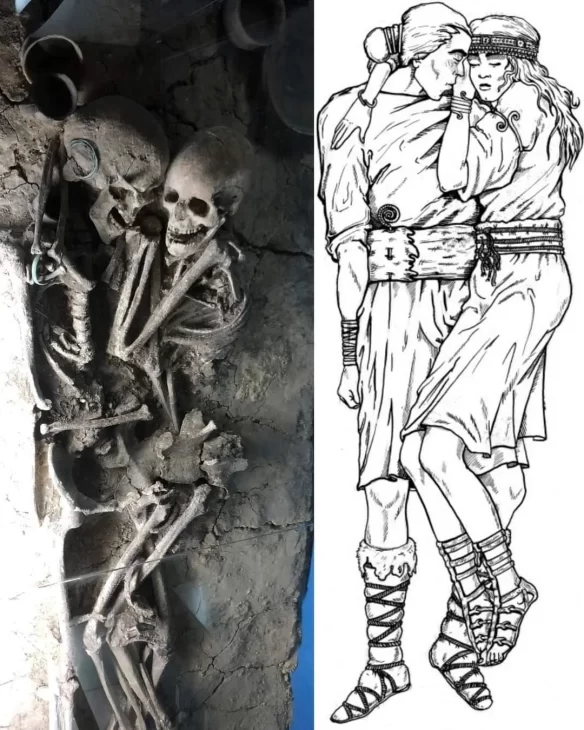
This one has informed the story I’m writing now (The Bear, which will be offered as a free serial when I’m done writing it… hopefully I’ll finish this year). This is a Bronze Age burial of a man and a woman in the Ukraine, near the town of Petrykiv. There is speculation that the woman elected to be buried with the man, possibly taking poison in order to join him in death. That’s not the part that caught my attention. What caught my attention, and thus my imagination, was the description of the burial:
It is a unique burial, a man and a woman lying there, hugging each other tight. Both faces were gazing at each other, their foreheads were touching. The woman was lying on her back, with her right arm she was tenderly hugging the man, her wrist lying on his right shoulder.
It’s such a sweet image, and it’s been in my head since I read about the discovery in 2018. Imagine being so in love with someone that you are buried together with them, forever in an embrace. Of course, such a burial requires an epic love story. I hope to deliver that. Of course, there are also demons and epic battles involved, because it’s me. But the kind of love between two people that would result in such a burial is the centre of this one.
For folks looking for inspiration for their fiction, particularly fantasy, I cannot recommend the academic fields of prehistoric anthropology and archaeology enough. So, I didn’t make a career out of my degree… Or, at least, not yet. If ever I manage to get to a point where my writing supports my life, then I can safely say that, at long last, I am using my degree. Not, you know, in the way I imagined when I graduated, but I wouldn’t be wasting my degree.
Are there any things in the realm of prehistory anthropology and archaeology that caught your eye and had you imagining stories to go with them? I’d love to hear about it!
When S.M. Carrière isn’t brutally killing your favorite characters, she spends her time teaching martial arts, live streaming video games, and cuddling her cat. In other words, she spends her time teaching others to kill, streaming her digital kills, and a cuddling furry murderer. Her most recent titles include Daughters of Britain, Skylark and Human. Her serial The New Haven Incident is free and goes up every Friday on her blog.
Women in SF&F Month: Linsey Miller
Today’s Women in SF&F Month guest is Linsey Miller! Her work in young adult speculative fiction includes “A Helping Hand” in the horror anthology The House Where Death Lives, “Give Up the Ghost” in the Lambda Award–nominated anthology Being Ace, the Lambda Literary Award–nominated dark fantasy novel What We Devour, and the fantasy novels in the Mask of Shadows duology (Mask of Shadows, Ruin of Stars). Coming out on June 3, her next book, That Devil, Ambition, is a standalone YA […]
The post Women in SF&F Month: Linsey Miller first appeared on Fantasy Cafe.Sensual Details in “Hands and Straight Lines” Envelop Your Attention
Carla Bradsher-Fredrick’s novel Hands and Straight Lines creates a calm yet unsettling zone of ambivalence…
The post Sensual Details in “Hands and Straight Lines” Envelop Your Attention appeared first on LitStack.
Teaser Tuesdays - The Twisted Ones
 So I put my dog in the truck and packed up a suitcase full of clothes, asked my aunt Kate to keep an eye on the house, and drove down to North Carolina.it's a long drive.
So I put my dog in the truck and packed up a suitcase full of clothes, asked my aunt Kate to keep an eye on the house, and drove down to North Carolina.it's a long drive.(page 7, The Twisted Ones by T. Kingfisher)
---------
Teaser Tuesdays is a weekly bookish meme, previously hosted by MizB of Should Be Reading. Anyone can play along! Just do the following: - Grab your current read - Open to a random page - Share two (2) “teaser” sentences from somewhere on that page BE CAREFUL NOT TO INCLUDE SPOILERS! (make sure that what you share doesn’t give too much away! You don’t want to ruin the book for others!) - Share the title & author, too, so that other TT participants can add the book to their TBR Lists if they like your teasers!
WHEN the WOLF COMES HOME by Nat Cassidy
Women in SF&F Month: Pat Murphy
Today’s Women in SF&F Month guest is Pat Murphy! Her work includes the short stories in Women Up to No Good, the Philip K. Dick Award–winning collection Points of Departure, and the Nebula Award–winning novel The Falling Woman. Pat’s latest SF&F novel—her first in more than 20 years—is The Adventures of Mary Darling. This subversive retelling of Peter Pan and Sherlock Holmes focuses on Mary Darling—the mother of the children who flew away with Peter Pan and the niece of […]
The post Women in SF&F Month: Pat Murphy first appeared on Fantasy Cafe.Spotlight on “My Name is Emilia del Valle” by Isabel Allende
In the spellbinding historical novel My Name is Emilia del Valle, a young writer journeys…
The post Spotlight on “My Name is Emilia del Valle” by Isabel Allende appeared first on LitStack.
A (Black) Gat in the Hand: William Patrick Murray – Who was N.V. Romero?
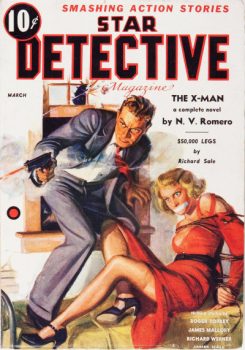 “You’re the second guy I’ve met within hours who seems to think a gat in the hand means a world by the tail.” – Phillip Marlowe in Raymond Chandler’s The Big Sleep
“You’re the second guy I’ve met within hours who seems to think a gat in the hand means a world by the tail.” – Phillip Marlowe in Raymond Chandler’s The Big Sleep
(Gat — Prohibition Era term for a gun. Shortened version of Gatling Gun)
Will Murray has graced this column multiple times, and he has delved into a mystery or two. He’s got another one today, looking into a Pulp byline from the nineteen thirties that has gnawed away at him. And by golly, Will finally had enough! Read on…
____________________________________________
For literally decades, I’ve been intrigued and baffled by the cryptic byline N. V. Romero, which was emblazoned on the front cover of the March, 1937 Star Detective Magazine.
I don’t remember where or when I picked up that old Red Circle pulp magazine. Probably at a collector’s convention somewhere in the 1970s or 80s. It grabbed my attention because the cover-featured lead novel bore the intriguing title,
“The X-Man.”
That’s a coinage I did not think existed prior to Marvel Comics releasing X-Men #1 in 1963. So I grabbed it. I probably paid about five bucks. It was in reasonably good condition. And it was published by Martin Goodman, who later launched Marvel Comics.
This issue is comparatively rare. My copy has the distinction of having been photographed so the cover could appear in Les Daniels’ 1990 book, Marvel, as a weird precursor to The X-Men.
The story Stan Lee always told was that he wanted to call his new comic book about a school for teenaged superheroes, The Mutants. Publisher Goodman objected to the title on the grounds that young readers might not know the term, and Lee claimed to have suggested The X–Men instead. The X stood for extra power.
If that’s true, it’s quite a coincidence that Lee independently coined the term X-Man more than 25 years after Goodman published a cover story by that name. Lee’s memory was not always reliable, and it could be self-serving. It would not shock me if Goodman actually suggested the new title based on his memory of this cover story. Goodman had the reputation of being cover-conscious, believing that covers and titles were the chief elements that sold magazines.
“The X-Man” is the first-person account of Texas special investigator Daniel “Dash” Antonio of the border city of La Plaza District Attorney’s office. It’s a hardboiled story that gets a little metaphysical in spots. In the year of 1937, the G-man was the rising hero in America, and in the pulp magazines. When he was framed for murder, Antonio starts calling himself “the X-Man.“
“I’m on the spot,” he complains. “Instead of being a G-man, I’m an X-man. Dash Antonio, X-Man.”
The novel was credited to N. V. Romero. That byline was unfamiliar to me. So when pulp magazines began to be indexed in depth, and those indexes posted online, I eagerly looked up the name.
It appeared only once in the tens of thousands of pulp magazines that had been indexed and cross-referenced. And that was for the lead novel of the March 1937 issue of Star Detective.
I thought that exceedingly strange. True, inexperienced authors did sell the occasional yarn to pulp magazines, and never appeared again.
There was a self-described “rank amateur” Missouri writer named Vaughn Bryant who sold a story entitled “The Stalking Satan” to Secret Agent X in 1935. He credited the sale to his agent, Lurton Blassingame. The submission ran in the October issue as “The Wailing Skull.”
Bryant apparently only sold that one story––or at least his byline appeared only once in a pulp magazine. Well, it happens that Secret Agent X was a bottom of the barrel market. As was Star Detective Magazine. Fledgling pulpsters more easily broke into the pages of such titles, as opposed to Black Mask. And many who managed one sale never made another.
But the beginners who sold the odd pulp yarn usually wrote short stories. “The X-Man” was a full-length novel. This suggested a seasoned professional.
For years, I puzzled over that unfamiliar name. I often wondered, Was there a clue to Romero’s true identity concealed in his initials? Phonetically, N. V. sounded like “envy.” That was a dead end. The ethic last name was unusual for a pulp magazine, which shunned anything that didn’t sound unequivocally Anglo-Saxon. That, and the one-time use all but ruled out the possibility that it was a house name.
There was one clue. The novel was set in the fictional town of La Plaza, Texas. I reasoned that the author would probably be a Texas native. My initial thoughts ran to Eugene Cunningham of El Paso, Texas, who primarily wrote Westerns, but did other things. But I had no way of tying Cunningham to Romero. I also considered Margie Harris, a Houston native known for writing detective and gangster stories.
Until it occurred to me to jump onto Newspapers.com and punch in that mysterious byline, limiting the search to Texas newspapers.
The first thing that popped up was a letter to the editor of the El Paso Times bylined N. V. Romero. It was dated October 30, 1937.
My researcher’s antennae lifted and quivered.
I had confidently assumed that N. V. Romero was a pseudonym for some prolific pulpster who preferred to conceal his identity because he wrote for the lower-paying Goodman group. Could it be that there was an actual N. V. Romero, and that unusual byline did not in fact mask anybody previously known to the reading public?
Searching further, I found several more letters and a few poems printed the El Paso Times.
It was beginning to seem as if Mr. Romero was nobody other than an unknown author––but also kind of a national non-entity.
One 1933 reference suggested that he worked as a grocer and ran the R. Gomez grocery store in El Paso.
But I had yet to discover absolute proof that this was the nebulous author of The X-Man. I continued scrolling.
Then I came across this gem in the El Paso Times‘ “Around Here” column for March 18, 1937:
AUTHORS DETECTIVE NOVEL.
“It might be interesting to note,” writes M. S. Salcido, “that N. V. Romero, who writes such nice poetry for the Sunday Book Page, has a hard and fast detective novel featured on the cover of the Star Detective Magazine for March.”
Columnist H. S. Hunter added:
“Thanks for the tip. It’s good to know when an El Pasoan comes out with either novel or short story, or accomplishes worthwhile work any other line, for that matter, and this column welcomes a chance to give him a hand.’
There it was––conclusive proof! Mr. Romero was real and he was the actual author of that oddball lead novel.
I was rather chagrined. Decades before, I had written an article on the subject for Comic Book Marketplace where I confidently asserted that N. V. Romero was almost certainly a pseudonym for a hitherto-unidentified pulp author.
It just goes to show that even though one might be considered an expert in the pulp field, it’s dangerous to jump to conclusions.
It’s also a good thing I’m a stubborn and indefatigable researcher. And that I had a subscription to Newspapers.com.
As would be expected of someone who did not go on to literary fame, few facts can be gleaned about this obscure writer.
The author was a lifelong resident of the border town of El Paso, which is the obvious inspiration for La Plaza. A reference to La Plaza’s unnamed sister city across the Rio Grande River points to Juarez, which lies on the other side of the Rio from El Paso.
According to one newspaper notice, in 1931 Romero was admitted to Kalevala, the English Honor Society of the El Paso High School. Out of 76 students who applied, he was one of only 16 admitted. Admission was based on a writing sample. So his inclination toward writing may have started there. Even as a high schooler, he was known as N. V. Romero.
Apparently, Romero never married, or had children. He lived at the same El Paso address for decades. Other than the odd car accident, his name only appeared in print when he wrote a letter or poem for publication in the El Paso Times, which he did periodically, always signing it N. V. Romero.
Popping over to Ancestry.com, I discovered the secret of those mysterious initials. Romero’s 1940 Draft registration card listed his full name as Nicolas Varela Romero, age 25, born March 10, 1915. Under remarks about his fitness to serve was written: “Lame—on crutches.” I assume therefore that the Draft did not take him.
His birthdate means that Romero wrote “The X–Man’ when he was only 20 or 21.
According to Newspapers.com, Mr. Romero died on March 3, 1998 at the age of 82. His past occupations were given as architect, notary public and small business accountant. A 1940s census listed his occupation at the age of 30 as self-employed architect, working for different companies. As far as I’m able to determine, Romero never published another line of fiction in a national magazine for the rest of his days. At least, not under any variation of his real name.…
Bob on Red Circle:
Martin Goodman formed Red Circle Magazines in 1935, and Red Circle cranked out a plethora of low-grade Pulps, including:
All Star Fiction, All Star Adventures, Star Detective, Star Sports, Sports Action, Adventure Trails, Complete Adventures, Complete Western Book, Detective Short Stories, Complete Detective, Complete Sports, Best Sports, Mystery Tales, Top-Notch Western, Top-Notch Detective, Two-Gun Western, Six-Gun Western, Gunsmoke Western, Sky Devils, Western Short Stories, Cowboy Action Novels, Quick-Trigger Western, Modern Love, Wild West Stories & Complete Novel Magazine, Real Sports, Ka-Zar, and Marvel Science Stories.
Star Detective was a Weird Menace Pulp and ran for eleven issues in 1935-1938. It was changed to Uncanny Tales, lasted five more issues and that was the end. But it was a low-end Pulp, never publishing more than three issues in a year and not making any impact, short or long term.
Star did have some notable names, including Hugh B. Cave, L. Ron Hubbard, E. Hoffman Price, Paul Cain, Roger Torrey, and Richard Sale.
2025 (2)
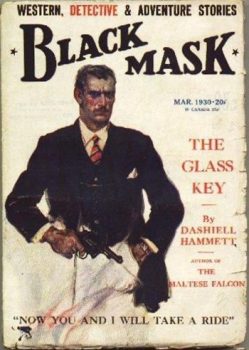 Shelfie – Dashiell Hammett
Shelfie – Dashiell Hammett
Windy City Pulp & Paper Fest – 2025
2024 Series (11)
Will Murray on Dashiell Hammett’s Elusive Glass Key
Ya Gotta Ask – Reprise
Rex Stout’s “The Mother of Invention”
Dime Detective, August, 1941
John D. MacDonald’s “Ring Around the Readhead”
Harboiled Manila – Raoul Whitfield’s Jo Gar
7 Upcoming A (Black) Gat in the Hand Attractions
Paul Cain’s Fast One (my intro)
Dashiell Hammett – The Girl with the Silver Eyes (my intro)
Richard Demming’s Manville Moon
More Thrilling Adventures from REH
Prior Posts in A (Black) Gat in the Hand – 2023 Series (15)
Back Down those Mean Streets in 2023
Will Murray on Hammett Didn’t Write “The Diamond Wager”
Dashiell Hammett – ZigZags of Treachery (my intro)
Ten Pulp Things I Think I Think
Evan Lewis on Cleve Adams
T,T, Flynn’s Mike & Trixie (The ‘Lost Intro’)
John Bullard on REH’s Rough and Ready Clowns of the West – Part I (Breckenridge Elkins)
John Bullard on REH’s Rough and Ready Clowns of the West – Part II
William Patrick Murray on Supernatural Westerns, and Crossing Genres
Erle Stanley Gardner’s ‘Getting Away With Murder (And ‘A Black (Gat)’ turns 100!)
James Reasoner on Robert E. Howard’s Trail Towns of the old West
Frank Schildiner on Solomon Kane
Paul Bishop on The Fists of Robert E. Howard
John Lawrence’s Cass Blue
Dave Hardy on REH’s El Borak
Prior posts in A (Black) Gat in the Hand – 2022 Series (16)
Asimov – Sci Fi Meets the Police Procedural
The Adventures of Christopher London
Weird Menace from Robert E. Howard
Spicy Adventures from Robert E. Howard
 Thrilling Adventures from Robert E. Howard
Thrilling Adventures from Robert E. Howard
Norbert Davis’ “The Gin Monkey”
Tracer Bullet
Shovel’s Painful Predicament
Back Porch Pulp #1
Wally Conger on ‘The Hollywood Troubleshooter Saga’
Arsenic and Old Lace
David Dodge
Glen Cook’s Garrett, PI
John Leslie’s Key West Private Eye
Back Porch Pulp #2
Norbert Davis’ Max Latin
Prior posts in A (Black) Gat in the Hand – 2021 Series (7 )
The Forgotten Black Masker – Norbert Davis
Appaloosa
A (Black) Gat in the Hand is Back!
Black Mask – March, 1932
Three Gun Terry Mack & Carroll John Daly
Bounty Hunters & Bail Bondsmen
Norbert Davis in Black Mask – Volume 1
Prior posts in A (Black) Gat in the Hand – 2020 Series (21)
Hardboiled May on TCM
Some Hardboiled streaming options
Johnny O’Clock (Dick Powell)
Hardboiled June on TCM
Bullets or Ballots (Humphrey Bogart)
Phililp Marlowe – Private Eye (Powers Boothe)
Cool and Lam
All Through the Night (Bogart)
Dick Powell as Yours Truly, Johnny Dollar
Hardboiled July on TCM
YTJD – The Emily Braddock Matter (John Lund)
Richard Diamond – The Betty Moran Case (Dick Powell)
 Bold Venture (Bogart & Bacall)
Bold Venture (Bogart & Bacall)
Hardboiled August on TCM
Norbert Davis – ‘Have one on the House’
with Steven H Silver: C.M. Kornbluth’s Pulp
Norbert Davis – ‘Don’t You Cry for Me’
Talking About Philip Marlowe
Steven H Silver Asks you to Name This Movie
Cajun Hardboiled – Dave Robicheaux
More Cool & Lam from Hard Case Crime
A (Black) Gat in the Hand – 2019 Series (15)
Back Deck Pulp Returns
A (Black) Gat in the Hand Returns
Will Murray on Doc Savage
Hugh B. Cave’s Peter Kane
Paul Bishop on Lance Spearman
A Man Called Spade
Hard Boiled Holmes
Duane Spurlock on T.T. Flynn
Andrew Salmon on Montreal Noir
Frank Schildiner on The Bad Guys of Pulp
Steve Scott on John D. MacDonald’s ‘Park Falkner’
William Patrick Murray on The Spider
John D. MacDonald & Mickey Spillane
Norbert Davis goes West(ern)
Bill Crider on The Brass Cupcake
A (Black) Gat in the Hand – 2018 Series (32)
George Harmon Coxe
Raoul Whitfield
Some Hard Boiled Anthologies
Frederick Nebel’s Donahue
Thomas Walsh
Black Mask – January, 1935
Norbert Davis’ Ben Shaley
D.L. Champion’s Rex Sackler
Dime Detective – August, 1939
Back Deck Pulp #1
W.T. Ballard’s Bill Lennox
Erle Stanley Gardner’s The Phantom Crook (Ed Jenkins)
Day Keene
Black Mask – October, 1933
Back Deck Pulp #2
Black Mask – Spring, 2017
Erle Stanley Gardner’s ‘The Shrieking Skeleton’
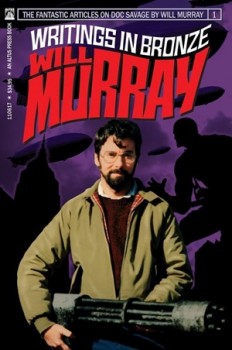 Frank Schildiner’s ‘Max Allen Collins & The Hard Boiled Hero’
Frank Schildiner’s ‘Max Allen Collins & The Hard Boiled Hero’
A (Black) Gat in the Hand: William Campbell Gault
A (Black) Gat in the Hand: More Cool & Lam From Hard Case Crime
MORE Cool & Lam!!!!
Thomas Parker’s ‘They Shoot Horses, Don’t They?’
Joe Bonadonna’s ‘Hardboiled Film Noir’ (Part One)
Joe Bonadonna’s ‘Hardboiled Film Noir’ (Part Two)
William Patrick Maynard’s ‘The Yellow Peril’
Andrew P Salmon’s ‘Frederick C. Davis’
Rory Gallagher’s ‘Continental Op’
Back Deck Pulp #3
Back Deck Pulp #4
Back Deck Pulp #5
Joe ‘Cap’ Shaw on Writing
Back Deck Pulp #6
The Black Mask Dinner
 There are some outstanding names in the ‘New Pulp’ field, but William Patrick Murray’s probably stands above them all. Along with Doc Savage, Will has written Tarzan and The Spider. And he’s quite the Sherlock Holmes writer. Short stories, comic books, radio plays, nonfiction essays and books – Murray has done it all. He created The Unbeatable Squirrel Girl for Marvel Comics, and his collection of essays on Doc Savage, Writings in Bronze, is a must read. I love a good book introduction, and Murray has written some fine ones for Steeger Books. Visit his website Adventures in Bronze.
There are some outstanding names in the ‘New Pulp’ field, but William Patrick Murray’s probably stands above them all. Along with Doc Savage, Will has written Tarzan and The Spider. And he’s quite the Sherlock Holmes writer. Short stories, comic books, radio plays, nonfiction essays and books – Murray has done it all. He created The Unbeatable Squirrel Girl for Marvel Comics, and his collection of essays on Doc Savage, Writings in Bronze, is a must read. I love a good book introduction, and Murray has written some fine ones for Steeger Books. Visit his website Adventures in Bronze.

Bob Byrne’s ‘A (Black) Gat in the Hand’ made its Black Gate debut in 2018 and has returned every summer since.
His ‘The Public Life of Sherlock Holmes’ column ran every Monday morning at Black Gate from March, 2014 through March, 2017. And he irregularly posts on Rex Stout’s gargantuan detective in ‘Nero Wolfe’s Brownstone.’ He is a member of the Praed Street Irregulars and founded www.SolarPons.com (the only website dedicated to the ‘Sherlock Holmes of Praed Street’).
He organized Black Gate’s award-nominated ‘Discovering Robert E. Howard’ series, as well as the award-winning ‘Hither Came Conan’ series. Which is now part of THE Definitive guide to Conan. He also organized 2023’s ‘Talking Tolkien.’
He has contributed stories to The MX Book of New Sherlock Holmes Stories — Parts III, IV, V, VI, XXI, and XXXIII.
He has written introductions for Steeger Books, and appeared in several magazines, including Black Mask, Sherlock Holmes Mystery Magazine, The Strand Magazine, and Sherlock Magazine.
You can definitely ‘experience the Bobness’ at Jason Waltz’s ’24? in 42′ podcast.
Review: A Song of Legends Lost by M.H. Ayinde

Buy A Song of Legends Lost
FORMAT/INFO: A Song of Legends Lost was published in the UK on April 8th, 2025, and will be published in the US on June 3rd, 2025. It is 592 pages long and available in paperback, ebook, and audiobook.
OVERVIEW/ANALYSIS: Everyone knows that only those of noble blood can invoke the ancestors, can call their spirits back to the mortal plane to fight in the wars against the greybloods. Or at least, that's what everyone thinks. But when a young woman in the slums summons a spirit, it sets off a chain reaction of events that will shift the Nine Lands forever. As families fight to determine the fate of the kingdom, one little detail slips through the cracks: not every spirit summoned is an ancestor.
A Song of Legends Lost is a truly unique science-fantasy story that will engross you as it keeps you guessing. It will be tempting for many of you to start this story and within a few chapters proclaim, "I know what's going on!" I certainly did that and I'm here to assure you that, like me, you will be wrong. This blend of magic and technology still has me (pleasantly) confused as to how it all ties together, as we only get a peek behind the curtain by the end of this first book.
The story immediately jumps into some bad situations with multiple characters, plunging you into the middle of things as you meet them. While a few POV characters stay the length of the book, some only stick around for chunks at a time, with the cast of POV characters changing as the story switches from Part 2 to Part 3, etc. This gives us a fairly wide view of the events that are playing out across the kingdom. The author does a good job overall of investing you in the characters, but given how much you jump around, I did occasionally find myself emotionally distanced from some characters more than others.
This is also a story that is working on two levels. On the surface you have the very real, sometimes deadly, political posturing between the monarchy, the powerful religious monks, and the noble families. But there is also a whole second layer of characters pulling strings for completely different reasons. To most, this is about protecting their power and protecting the Nine Lands from the dangerous graybloods. But to others, these power struggles are masking a completely different game. We don't know fully what's going on by the end of things, just that we are still in the dark about quite a lot.
That's where this story may be a bit frustrating for some. We only have a tantalizing glimpse of what's truly going on, with much mystery still to be unpacked in the subsequent sequels. Personally, there is plenty of adventure and growth to be found just in this book alone, but I did plead a little bit at the end to please give me just a liiiittle more detail of what's really going on? Please?
CONCLUSION: But in the end, that's while I'll be back for the sequel to A Song of Legends Lost. The author is clearly just getting started and I am ready to go along for the ride (especially after one especially juicy POV in the epilogue). If you're looking for something fresh and original to dive into, I wholly recommend checking out this story.



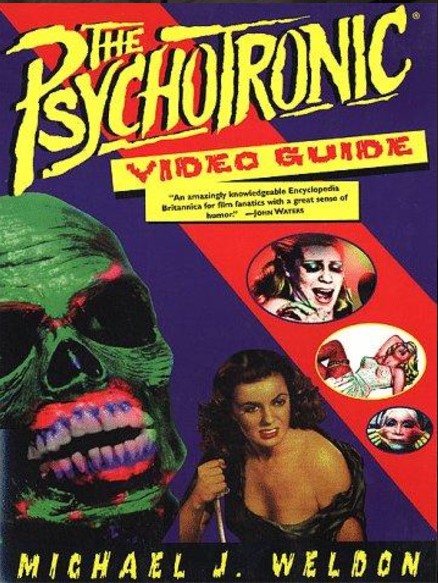
Recent comments